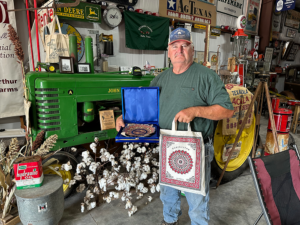Welcome to the August 4, 2023 issue of Cotton News, a service provided by Plains Cotton Growers Inc. for the cotton industry in the Texas High Plains and beyond.

Pictured (left to right): Mauricio Ulloa, Ph.D., USDA-ARS Research Geneticist; Zabardast Buriev, Ph.D., Academy Sciences of Uzbekistan Center of Genomics and Bioinformatics Director; Bunyod Mamarakhimov, Ph.D., Tashkent State Agarian University Center for Cotton Seed Production Director; Lloyd Arthur, Crosby County producer; David Arthur, Lloyd’s son; Shukhrat Otajonov, Ph.D., Republic of Uzbekistan Ministry of Higher Education, Science and Innovation Department Head; Shodmon Namozov, Ph.D., Research Institute of Breeding, Seed Production and Agricultural Technology of Cotton Cultivation Director. Not pictured: Sherbek Ibragimov, Republic of Uzbekistan Ministry of Higher Education, Science and Innovation Expert.
Uzbekistan Delegation Tours Crosby County Farm
While Uzbekistan is different than West Texas in terms of structure, history and climate, farming isn’t.
“It’s funny how just talking farming, we can all face the same challenges regardless of geographic location,” said Lloyd Arthur, Crosby County producer. “They have some challenges we don’t, obviously, and vice versa, but at the end of the day farmers can find common ground with other farmers no matter where any of us come from.”
 Uzbekistan has an arid climate similar to West Texas; however, it typically doesn’t get hotter than 80 degrees Fahrenheit in the summer with colder winters. Before USSR was dissolved in 1991, 100% of Uzbekistan crops were cotton. Today it’s 80%.
Uzbekistan has an arid climate similar to West Texas; however, it typically doesn’t get hotter than 80 degrees Fahrenheit in the summer with colder winters. Before USSR was dissolved in 1991, 100% of Uzbekistan crops were cotton. Today it’s 80%.
Most of Uzbekistan cotton is hand picked. The supply chain is “in-house” in their country, as harvested cotton is processed, milled and spun all within Uzbekistan.
“They do have more water than we do — most of it is flood irrigation,” added Arthur. “I showed them my drip irrigation and how we have to conserve water out here in West Texas.”
The Uzbekistan delegation was brought out to our part of the world by Mauricio Ulloa, Ph.D., research geneticist for the U.S. Department of Agriculture, Agricultural Research Service (ARS), who has been collaborating with Uzbekistan since 2007.

The Uzbekistan delegation gifted Lloyd Arthur with tokens from their country.
ARS partners with the Uzbekistan Center of Genomics and Bioinformatics on cooperative research projects to control and identify resistance to the highly contagious Fusarium wilt pathogen, which threatens cotton production in both countries. The partnership also includes work identifying and developing resilient gerplasm to plant stress and diseases.
“While I have been in collaboration with most of these men for many years, this was their first time to come visit,” Ulloa said. “It was a great experience to be able to show them cotton in this part of the world. We appreciate Lloyd for showing us his farm, farm equipment, and sharing his farming practices with us.”
2023 Crop Outlook Better Than Last Year
Last August, PCG predicted 60% to 70% abandonment in the High Plains region for the 2022 crop. Turns out, the estimate was conservative as the actual percentage was just shy of 80%.
Producers experienced a better start to the season for the 2023 crop, as much needed rainfall was received in the area. While some of the rain was problematic, most everyone agrees they would rather have rain than not, regardless of when it decides to come.
Many PCG counties were able to get a crop up this year, different than last year, but another rain is needed to keep it going.
Most of the northern Panhandle counties lost their cotton to poorly timed precipitation and storms, but with a good rain, the southern High Plains could see a much better dryland crop than last year. Even so, PCG is predicting a 35% to 40% abandonment for 2023.
Pest Pressure Increase
The 2023 crop has seen more insect pressure than was present last year. However, the balance of beneficial bugs to pests has these IPM agents feeling optimistic.
Cochran, Hockley and Lamb Counties
According to IPM agent Kerry Siders, small clusters of three- and five-colony aphids are present in fields. For now, the beneficials (spiders, etc) are taking care of them.
“But it wouldn’t take much to tip the scales in the aphid’s favor,” he added. “The wrong selection of insecticide could remove your beneficials, too, so make sure what you’re using is specific to aphids.”
Gaines County
The beneficial pest population is “phenomenal this year,” according to IPM agent Keegan McCollum.
“Our organic fields have had some Lygus problems,” he added. “And we have had some fields sprayed for stink bugs and leaf-footed bugs.”
Bailey, Castro and Parmer Counties
“We’re on the lookout for boll worms this month as we have a couple of full moons coming,” said IPM agent John Thobe. “These full moons may increase the flight pattern, so we’re getting ready for that possibility.”
Hale and Swisher Counties
IPM agent Blayne Reed noted that his fields have seen quite a few boll worm eggs recently and some worms have already hatched out, yet not quite at threshold. “While the beneficial populations are good, there is a lot going on in fields right now and we need to be alert.”
To listen to the High Plains IPM Podcast, click here.